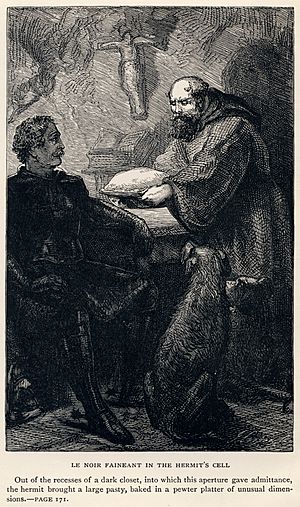Ivanhoe facts for kids
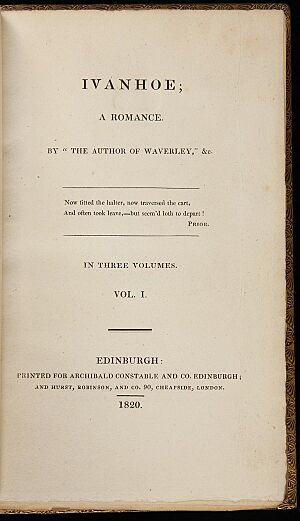
Title page of 1st edition (1820, but released in December 1819)
|
|
| Author | Walter Scott |
|---|---|
| Country | Great Britain |
| Language | English |
| Series | Waverley Novels |
| Genre | Historical novel, chivalric romance |
| Publisher | Archibald Constable (Edinburgh); Hurst, Robinson, and Co. (London) |
|
Publication date
|
20 December 1819 |
| Media type | |
| Pages | 401 (Edinburgh Edition, 1998) |
| Preceded by | A Legend of Montrose |
| Followed by | The Monastery |
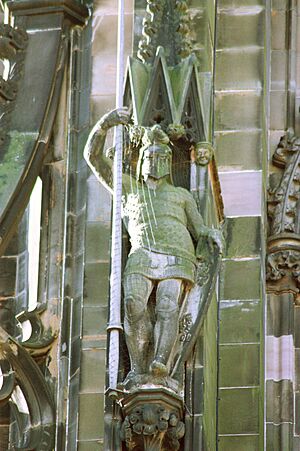
Ivanhoe: A Romance is a famous historical novel written by Walter Scott. It was first published in December 1819. This book was different from Scott's earlier stories, which were usually set in Scotland. Ivanhoe quickly became one of his most popular and important novels.
The story takes place in England in the Middle Ages, around the year 1194. It is full of exciting events like tournaments, brave outlaws, and conflicts between different groups. The novel shows the struggles between Jews and Christians, and between the Normans and Saxons. Many people, including famous writers, believed Ivanhoe helped make people more interested in chivalric romance and the medieval period. It also shaped how people thought about historical figures like King Richard the Lionheart, Prince John, and Robin Hood.
Contents
How the Story Was Written
Walter Scott started writing Ivanhoe in July 1819. He sometimes dictated the story because he was not feeling well. He finished writing it in November 1819.
To make the story feel real, Scott studied many old books about the Middle Ages. He learned about how people lived, dressed, and played sports back then. He also read history books about the Anglo-Saxons and Normans. Scott even used ideas from old stories about Robin Hood to create characters like Locksley.
About the Book's Editions
Ivanhoe was first published by Archibald Constable in Edinburgh. Although the first editions show the date 1820, the book was actually released on December 20, 1819. Like Scott's other novels before 1827, it was published without the author's name. About 10,000 copies were printed. Scott later made some changes to the text for a special 'Magnum' edition in 1829.
Today, the most common version of the book is from the Edinburgh Edition of the Waverley Novels, published in 1998.
What Happens in Ivanhoe?
Ivanhoe is set in 1194. It focuses on one of the last noble Anglo-Saxon families in England. At this time, most of the nobles were Norman. The story follows Sir Wilfred of Ivanhoe. His father is upset with him because Ivanhoe supports the Norman king, Richard the Lionheart. After the Third Crusade ended, many Crusaders were returning home. King Richard had been captured by Leopold of Austria on his way back to England. People believed he was still a prisoner.
The Story Begins
Wilfred of Ivanhoe is disowned by his father, Cedric of Rotherwood. This happens because Ivanhoe supports King Richard. He also fell in love with Lady Rowena, who was Cedric's ward. Cedric wanted Rowena to marry Lord Athelstane, a powerful Saxon nobleman. Athelstane hoped to become King of England. Ivanhoe went with King Richard on the Third Crusade and fought bravely.
The book starts with Norman knights and religious leaders seeking a place to stay at Cedric's home. A palmer (a pilgrim) guides them there. That same night, Isaac of York, a Jewish moneylender, also arrives. He is on his way to a tournament. The palmer overhears one of the Normans, the Templar Brian de Bois-Guilbert, planning to capture Isaac.
The palmer helps Isaac escape from Rotherwood. Cedric's swineherd Gurth also helps. Isaac offers to repay the palmer by giving him a suit of armor and a war horse. Isaac guesses that the palmer is secretly a knight. The palmer is surprised but accepts the offer.
The Great Tournament
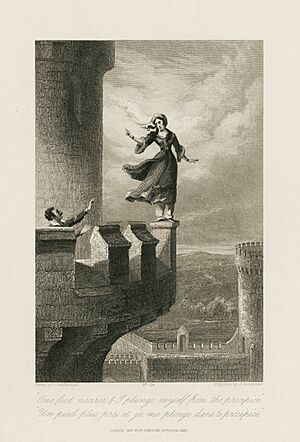
Prince John leads the tournament. Many important people are there, including Cedric, Athelstane, Lady Rowena, Isaac of York, and his daughter Rebecca. Robin of Locksley and his men are also present.
On the first day, a mysterious knight calls himself "Desdichado," meaning "Disinherited." He defeats Bois-Guilbert in a joust. The masked knight does not show his face, but he is declared the champion. He chooses Lady Rowena as the Queen of the Tournament.
On the second day, in a group fight, Desdichado leads one team. He is in trouble until a knight called Le Noir Faineant ('the Black Sluggard') helps him. This knight then leaves secretly. When Desdichado has to remove his mask to receive his prize, he is revealed as Wilfred of Ivanhoe. Prince John and his court are worried because they fear King Richard's return.
Ivanhoe is badly hurt in the tournament. His father does not help him. Instead, Rebecca, who is a skilled physician, cares for him. She convinces her father to take Ivanhoe with them to their home in York. The tournament also features an archery contest, where Locksley shows amazing skill by splitting a willow reed with his arrow.
Captured and Rescued!
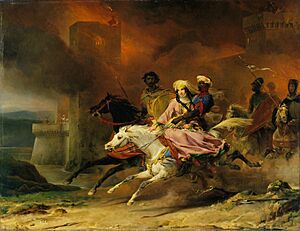
In the forests between Ashby and York, Isaac, Rebecca, and the wounded Ivanhoe are left alone by their guards. The guards are afraid of bandits. Cedric, Athelstane, and Lady Rowena meet them and decide to travel together. However, the whole group is captured by de Bracy and his friends. They are taken to Torquilstone, the castle of Front-de-Bœuf. Gurth the swineherd and Wamba the jester escape. They meet Locksley, who plans a rescue.
The Black Knight, who had been staying with local friar, hears about the captives from Robin of Locksley. He agrees to help. They attack Torquilstone Castle with Robin's men. Inside the castle, de Bracy tries to win Lady Rowena's love, but she refuses him. Brian de Bois-Guilbert captures Rebecca. He tries to make her his own, but she bravely refuses. Front-de-Bœuf tries to get a large ransom from Isaac, but Isaac refuses to pay unless his daughter is freed.
The attackers send a message demanding the captives be released. The Normans ask for a priest to visit Cedric. Cedric's jester Wamba dresses as a priest and takes Cedric's place. Cedric escapes and tells the attackers important information about the castle. On his way out, Cedric meets Ulrica, a Saxon woman. She vows revenge on Front-de-Bœuf and tells Cedric to inform the attackers. The attackers storm the castle. Ulrica, whose family had been wronged by Front-de-Bœuf, sets the castle on fire for revenge. Front-de-Bœuf dies in the fire. De Bracy surrenders to the Black Knight, who reveals himself as King Richard and lets de Bracy go. Bois-Guilbert escapes with Rebecca. Lady Rowena is saved by Cedric. King Richard rescues the wounded Ivanhoe from the burning castle. Athelstane is hurt and thought to be dead while trying to save Rebecca, whom he mistakes for Rowena.
Rebecca's Trial and Ivanhoe's Return
After the battle, Locksley hosts King Richard. Prince John learns from de Bracy that the King has returned and Torquilstone has fallen. Meanwhile, Bois-Guilbert takes Rebecca to a Templar meeting place. Lucas de Beaumanoir, the Grand Master of the Templars, is angry about Bois-Guilbert's feelings for Rebecca. He puts Rebecca on trial for witchcraft. Bois-Guilbert secretly wants to fight for Rebecca, but the Grand Master orders him to fight against her. Rebecca asks for a trial by combat, where a champion fights for her. She writes to her father to find someone to fight for her.
Cedric arranges Athelstane's funeral. The Black Knight arrives with Ivanhoe. Cedric is still upset with the Black Knight when he learns he is King Richard. But Richard calms Cedric and helps him make peace with Ivanhoe. During this talk, Athelstane appears! He was not dead, but had been placed in his coffin alive by monks who wanted the funeral money. Athelstane promises to support King Richard. He also tells Cedric to let Rowena marry Ivanhoe. Cedric finally agrees.
Soon after, Ivanhoe receives a message from Isaac asking him to fight for Rebecca. Ivanhoe rides day and night and arrives just in time for the trial by combat. He is very tired, and his horse is exhausted. Bois-Guilbert refuses to fight at first, but Ivanhoe challenges his honor. Bois-Guilbert becomes angry and prepares for combat. The two knights charge at each other. Ivanhoe and his horse fall, but Bois-Guilbert also falls, even though he was barely touched. Ivanhoe quickly gets up, but Bois-Guilbert does not rise. He dies from his strong emotions.
Ivanhoe and Rowena marry and live a long, happy life. Rebecca and her father decide to leave England for Granada to avoid more trouble. Before leaving, Rebecca visits Rowena to say goodbye. Ivanhoe's military service ends when King Richard dies five years later.
Meet the Characters
(important characters are in bold)
- Cedric the Saxon, a noble landowner
- Wilfred of Ivanhoe, Cedric's son and the hero
- Rowena, a Saxon princess and Cedric's ward
- Athelstane, a Saxon nobleman and Cedric's relative
- Gurth, Cedric's swineherd (pig keeper)
- Wamba, Cedric's jester (a joker)
- The Prior of Aymer, an abbot (head of a monastery)
- Brian de Bois-Guilbert, a Templar knight
- Isaac of York, a Jewish moneylender
- Rebecca, Isaac's daughter, a skilled healer and kind person
- King Richard ('the Black Knight'), the true King of England
- Prince John, Richard's brother
- Alias Locksley, also known as Robin Hood, an outlaw
- Reginald Front-de-Bœuf of Torquilstone, a Norman lord
- Maurice de Bracy, a mercenary (a soldier for hire)
- Friar Tuck, a local friar
- Ulrica, a Saxon woman seeking revenge
- Lucas de Beaumanoir, the Grand Master of the Templars
The Story's Style
Some people think Ivanhoe is a romantic adventure story, especially good for young readers. It has many parts of a classic adventure, like a hero's journey, brave knights, and fixing a broken society. Other people say the novel tells a realistic and lively story. It does not make the past or its main character seem perfect.
Main Ideas in Ivanhoe
Scott explores ideas in Ivanhoe that are similar to his other novels. He looks at the struggle between old heroic ideals and newer ways of life. In Ivanhoe, the Normans represent a more advanced culture, while the Saxons are poorer and resentful of Norman rule. The story shows how these two groups come together to form one united England.
Both groups have to give up some of their old ways to find peace. The Saxons must accept that their old cause is hopeless. The Normans must learn to overcome their greed and violence. Ivanhoe and King Richard represent the hope for a united future.
Ivanhoe, even though he is from a noble family, is shown as a regular person in the medieval class system. He is not a super-hero like some ancient Greek heroes. This makes the story feel more real and helps readers understand the social and cultural history of the time.
Real Places and History in the Book
The novel takes place in southern Yorkshire, north-west Leicestershire, and northern Nottinghamshire in England. Some castles mentioned include Ashby de la Zouch Castle (now a ruin) and 'Coningsburgh', which is based on Conisbrough Castle. The story also mentions York Minster, a famous cathedral.
The town of Conisbrough is so connected to Ivanhoe that many of its streets and buildings are named after characters from the book.
Walter Scott got the name "Ivanhoe" from the village of Ivinghoe in Buckinghamshire. He likely knew about Ivinghoe and researched it before using the name for his novel.
How Ivanhoe Shaped Robin Hood's Story
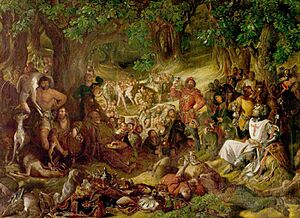
The way we think of Robin Hood today—as a cheerful, good, and patriotic rebel—owes a lot to Ivanhoe.
Scott's novel gave Robin Hood the name "Locksley." This name has been used ever since to refer to the legendary outlaw. Scott also made the conflict between Saxons and Normans a big part of the Robin Hood legend. Before Ivanhoe, old Robin Hood stories did not mention this conflict.
Many movies about Robin Hood, like the 1938 film The Adventures of Robin Hood with Errol Flynn, show Robin Hood with traits similar to Ivanhoe. Both Ivanhoe and Robin are returning Crusaders. They are proud Saxons, have a strong sense of justice, and support the rightful king. They are also skilled with weapons and fall in love with a "fair maid."
Scott also made the 12th century the popular time for Robin Hood's adventures. This was to make his novel more exciting. Earlier stories often placed Robin Hood much later. Robin's famous trick of splitting his competitor's arrow in an archery contest first appears in Ivanhoe.
Is the Story Historically Accurate?
The general historical events in the novel are mostly correct. The story takes place after King Richard's imprisonment and his return to England. However, the story is also largely fictional. Scott himself admitted he changed some historical details for the sake of the story. It is important to remember that Ivanhoe is a novel, not a history book.
Some historians have pointed out that the strong hatred between Saxons and Normans shown in the book might not have been as intense in Richard's time. By the late 1100s, many Saxons and Normans had married each other and blended their cultures. They often called themselves "English."
However, some experts believe Scott used Ivanhoe to show parallels between the Norman Conquest and the union of Scotland with England. Scott was Scottish and wanted to show both his love for Scotland and his support for the union.
The novel also created a new name in English: "Cedric." The original Saxon name was "Cerdic," but Scott misspelled it.
There are a few small historical errors in the book. For example, Rebecca, a Jewish woman, would likely not have been charged with witchcraft in England in 1194. Also, the punishment for witchcraft in England was usually hanging, not burning. The Grand Master of the Templars in the book, Lucas de Beaumanoir, was a different person in real history. Despite these small details, Ivanhoe does offer some interesting insights. It sometimes shows King Richard as someone who loves adventure more than his people's well-being. This is a more balanced view than the overly romantic ideas of Richard at the time.
More Ivanhoe Stories
- In 1850, the writer William Makepeace Thackeray wrote a funny follow-up to Ivanhoe called Rebecca and Rowena.
- Edward Eager's book Knight's Castle (1956) magically transports four children into the story of Ivanhoe.
- Simon Hawke used the story for The Ivanhoe Gambit (1984), a time travel adventure novel.
- Other authors have also written sequels, like Pierre Efratas with Le Destin d'Ivanhoe (2003) and Christopher Vogler with Ravenskull (2006).
Ivanhoe on Screen and Stage
The novel has been made into many movies and TV shows.
Movies About Ivanhoe
- Ivanhoe, United States 1911, directed by J. Stuart Blackton
- Ivanhoe, United States 1913, directed by Herbert Brenon
- Ivanhoe, Wales 1913, directed by Leedham Bantock
- Ivanhoe, 1952, starring Robert Taylor and Elizabeth Taylor; it was nominated for three Oscars.
- The Revenge of Ivanhoe (1965)
- Ivanhoe, the Norman Swordsman (1971)
- The Ballad of the Valiant Knight Ivanhoe (1983) from the USSR.
TV Shows About Ivanhoe
- 1958: A TV series starring Roger Moore as Ivanhoe.
- 1970: A TV miniseries starring Eric Flynn.
- 1975: Children's Animated Classics Ivanhoe.
- 1982: Ivanhoe, a TV movie starring Anthony Andrews.
- 1986: Ivanhoe, an animated TV movie by Burbank Films.
- 1995: Young Ivanhoe, a TV movie.
- 1995: "Sniffing the Gauntlet", an episode of the PBS show Wishbone that retold parts of Ivanhoe.
- 1997: Ivanhoe the King's Knight, a cartoon series.
- 1997: Ivanhoe, a 6-part TV miniseries by A&E and BBC.
- 1999: The Legend of Ivanhoe, an English-dubbed TV production.
- 2000–2002: Dark Knight, a New Zealand/British series.
- 2017: The Heroic Quest of the Valiant Prince Ivandoe, a Danish/British animated comedy.
Ivanhoe as an Opera
Several operas have been based on Ivanhoe. Victor Sieg's Ivanhoé won an award in 1864. Arthur Sullivan (famous for his operettas with W. S. Gilbert) also wrote a grand opera called Ivanhoe in 1891. Other composers like Gioachino Rossini and Otto Nicolai also created operas inspired by the novel.
Ivanhoe's Lasting Impact
The railway line near Ashby-de-la-Zouch was known as the Ivanhoe line for many years, named after the book's setting.
A part of the Silver Lake neighborhood in Los Angeles was named Ivanhoe in 1887. Many streets in the area are also named after Scott's other works and characters, like Locksley and Rowena.
Ivanhoe, North Carolina is also named after the novel.
See also
 In Spanish: Ivanhoe para niños
In Spanish: Ivanhoe para niños
- Norman yoke
- Trysting Tree


